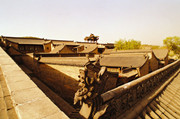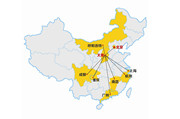Northern China's First Ancient Castle
Updated: 2012-03-01
The five-storied house, with a smooth and bright mirror-like surface in Xiangyu village, is by far the best-preserved storied residence in Northern China. Its outer cornices and pendant door and window columns are engraved with various designs symbolizing the Sun family architecture. The side rooms are one storey higher than the principal rooms, which is the typical western architectural style rarely seen in structures before the Ming Dynasty. Shang village, the former residence of Yan Xishan's secretary -- the biggest warlord in Shanxi Province -- is a rare harmonious combination of Chinese and western architectural styles in the Qinhe River Valley.
Inside the castles, the courtyards and buildings are linked via crisscrossing tunnels or arcades like a network of labyrinths, reflecting the Chinese rational concept of defense and communications.
According to architectural experts, compared to the historic merchant compounds in Shanxi Province, Qinhe River Valley ancient castles, with their impressive appeal and magnificence, better reflect the breadth of vision of ancient merchants and officials, witnessing the unique history of the rich households in the valley. Compared to the tulou, or earth buildings, in Southeast China's Fujinan Province, which have already been listed as a world cultural heritage, the castles are different in approach but equally satisfactory in terms of architectural features: encircled castles with an open interior, enhancing the military defensive functions. More and more, the mysterious ancient castles are becoming an attractive new scenic spot for explorers.




